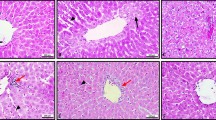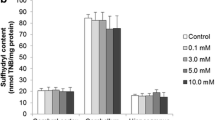Abstract
Oxidative stress is a hypothesis for the association of reactive oxygen species with cerebrovascular and neurodegenerative diseases. Thus, we examined whether oral betaine can act as a preventive agent in ethanol-induced oxidative stress on the cerebellum of rats. Thirty-two adult male Sprague–Dawley rats were divided into four equal groups (control, ethanol, betaine, and betaine plus ethanol) with different dietary regimens and were followed up for 1 month. Total homocysteine (tHcy) of plasma and cerebellum homogenate was determined by an Axis® homocysteine EIA kit, and antioxidant enzyme (glutathione peroxidase (GPx), SOD, and CAT) activities of cerebellum homogenate were measured chemically by a spectrophotometer. Lipid peroxidation of cerebellum was shown by the measurement of thiobarbituric reactive substances (TBARS) via a spectrophotometer. Ethanol-induced hyperhomocysteinemia was manifested by an increase in the concentrations of tHcy in the plasma and cerebellum homogenates of the ethanol group, while ethanol-induced oxidative stress was indicated via an increase in lipid peroxidation marker (TBARS) in cerebellum homogenates of ethanol-treated rats. In contrast, betaine prevented hyperhomocysteinemia and oxidative stress in the betaine plus ethanol group as well as the betaine group. The results of the present investigation indicated that the protective effect of betaine is probably related to its ability to strengthen the cerebellum membrane cells by enhancement of antioxidant enzyme activity principally GPx, while the methyl donor effect of betaine to reduce hyperhomocysteinemia has been explained previously and confirmed in the present study.




Similar content being viewed by others
References
Alirezaei M, Saeb M, Javidnia K, Nazifi S, Khalighyan N, Saeb S (2010) Betaine reduction of hyperhomocysteinemia and enhancement of 5-hydroxyindoleacetic acid in ethanol-induced hyperhomocysteinemia in rabbits. Afr J Biochem Res 4:246–254
Alirezaei M, Saeb M, Javidnia K, Nazifi S, Saeb S (2011) Hyperhomocysteinemia reduction in ethanol-fed rabbits by oral betaine. Comp Clin Pathol. doi:10.1007/s00580-010-1110-6
Anandan R, Devi KP, Devaki T, Govindaraj P (1998) Preventive effects of Picrochiza kurroa on d-galactosamine-induced hepatitis in rats. J Clin Biochem Nutr 25:87–95
Augustyniak A, Michalak K, Skrzydlewska E (2005) The action of oxidative stress induced by ethanol on the central nervous system (CNS). Postepy Hig Med Dosw 59:464–471
Austin RC, Sood SK, Dorward AM, Singh G, Shaughnessy SG, Pamidi S, Outinen PA, Weitz JI (1998) Homocysteine-dependent alterations in mitochondrial gene expression, function and structure. Homocysteine and H2O2 act synergistically to enhance mitochondrial damage. J Biol Chem 273:30808–30817
Barak AJ, Beckenhauer HC, Badakhsh S, Tuma DJ (1997) The effect of betaine in reversing alcoholic steatosis. Alcohol Clin Exp Res 21:1100–1102
Barak AJ, Beckenhauer HC, Tuma DJ (2002) Methionine synthase a possible prime site of the ethanolic lesion in liver. Alcohol 26:65–67
Barak AJ, Tuma DJ (1983) Betaine, metabolic by-product or vital methylating agent? Life Sci 32:771
Baraona E, Zeballos GA, Shoichet L, Mak KM, Lieber CS (2002) Ethanol consumption increases nitric oxide production in rats, and its peroxynitrite-mediated toxicity is attenuated by polyenylphosphatidylcholine. Alcohol Clin Exp Res 26:883–889
Barichello T, Fortunato JJ, Vitali AM et al (2006) Oxidative variables in the rat brain after sepsis induced by cecal ligation and perforation. Crit Care Med 34:886–889
Bergamini CM, Gambetti S, Dondi A, Cervellati C (2004) Oxygen, reactive oxygen species and tissue damage. Curr Pharm Des 10:1611–1626
Bidulescu A, Chambless LE, Siega-Riz AM, Zeisel SH, Heiss G (2009) Repeatability and measurement error in the assessment of choline and betaine dietary intake: the Atherosclerosis Risk in Communities (ARIC) Study. Nutr J 8:14–20
Bleich S, Degner D, Sperling W, Bönsch D, Thürauf N, Kornhuber J (2004) Homocysteine as a neurotoxin in chronic alcoholism. Prog Neuropsychopharmacol Biol Psychiat 28:453–464
Bottiglieri T (2005) Homocysteine and folate metabolism in depression. Neuropsychopharmacol Biol Psychiat 29:1103–1112
Bottiglieri T, Laundy M, Crellin R, Toone BK, Carney MWP, Reynolds EH (2000) Homocysteine, folate, methylation, and monoamine metabolism in depression. Br Med J 69:228–232
Broch OJ, Ueland PM (1984) Regional distribution of homocysteine in the mammalian brain. J Neurochem 43:1755–1757
Butterworth RF (1999) Pathophysiology of alcoholic brain damage: synergistic effects of ethanol, thiamine deficiency and alcoholic liver disease. Metab Brain Dis 10:1–8
Chen Z, Schwahn BC, Wu Q, He X, Rozen R (2005) Postnatal cerebellar defects in mice deficient in methylenetetrahydrofolate reductase. Inter J Dev Neurosci 23:465–474
Chen SY, Sulik K (1996) Free radicals and ethanol-induced cytotoxicity in neural crest cells. Alcohol Clin Exp Res 20:1071–1076
Claiborne A (1986) Catalase activity. In: Greenwald RA (ed) CRC handbook of methods for oxygen radical research. CRC Press, Boca Raton, pp 283–284
Craig SA (2004) Betaine in human nutrition. Am J Clin Nutr 80:539–549
D’Emilia DM, Lipton SA (1999) Ratio of S-nitrosohomocyst(e)ine to homocyst(e)ine or other thiols determines neurotoxicity in rat cerebrocortical cultures. Neurosci Lett 265:103–106
Dal-Pizzol F, Ritter C, Cassol-Jr OJ, Rezin GT, Petronilho F, Zugno AI, Quevedo J, Streck EL (2010) Oxidative mechanisms of brain dysfunction during sepsis. Neurochir Res 35:1–12
Erman F, Balkan J, Cevikbas U, Kocak-Toker N, Uysal M (2004) Betaine or taurine administration prevents fibrosis and lipid peroxidation induced by rat liver by ethanol plus carbon tetrachloride intoxication. Amino Acids 27:199–205
Finkelstein JD (2007) Metabolic regulatory properties of S-adenosylmethionine and S-adenosylhomocysteine. Clin Chem Lab Med 45:1694–1699
Finkelstein JD, Martin JJ (1986) Methionine metabolism in mammals. Adaptation to methionine excess. J Biol Chem 261:1582–1587
Finkelstein JD, Martin JJ, Harris BJ, Kyle WE (1983) Regulation of hepatic betaine-homocysteine methyltransferase by dietary betaine. J Nutr 113:519
Ganesan B, Buddhan S, Anandan R, Sivakumar R, Anbinezhilan R (2010) Antioxidant defense of betaine against isoprenaline-induced myocardial infarction in rats. Mole Biol Rep 37(3):1319–1327
Golbahar J, Aminzadeh MA, Hamidi SA, Omrani GR (2005) Association of red blood cell 5-methyltetrahydrofolate folate with bone mineral density in postmenopausal Iranian women. Osteop Inter 16:1894–1898
Haubrich DR, Gerber NH (1981) Choline dehydrogenase. Assay, properties and inhibitors. Biochem Pharmacol 30:2993
Heaton MB, Mitchell JJ, Paiva M (2000) Amelioration of ethanol-induced neurotoxicity in the neonatal rat central nervous system by antioxidant therapy. Alcohol Clin Exp Res 24:512–518
Huang RF, Huang SM, Lin BS, Wei JS, Liu TZ (2001) Homocysteine thiolactone induces apoptotic DNA damage mediated by increased intracellular hydrogen peroxide and caspase 3 activation in HL-60 cells. Life Sci 68:2799–2811
Ji C, Kaplowitz N (2003) Betaine decreases hyperhomocysteinemia, endoplasmic reticulum stress, and liver injury in alcohol-fed mice. Gastroenterology 124:1488–1499
Kalra J, Lautner K, Massey L, Prasad K (1988) Oxygen free radicals induced release of lysosomal enzymes in vitro. Mol Cell Biochem 84:233–238
Kanbak G, Arslan OC, Dokumacioglu A, Kartkaya K, Inal ME (2008) Effects of chronic ethanol consumption on brain synaptosomes and protective role of betaine. Neurochem Res 33:539–544
Karthikeyan G, Thachil A, Sharma S, Kalaivani M, Ramakrishnan L (2007) Elevated high sensitivity CRP levels in patients with mitral stenosis and left atrial thrombus. Inter J Cardiol 122:252–254
Kharbanda KK, Mailliard ME, Baldwin CR, Beckenhauer HC, Sorrell MF, Tuma DJ (2007) Betaine attenuates alcoholic steatosis by restoring phosphatidylcholine generation via the phosphatidylethanolamine methyltransferase pathway. J Hepatol 46:314–321
Kim JM, Stewart R, Kim SW, Yang SJ, Shin IS, Yoon JS (2008) Predictive value of folate, vitamin B12 and homocysteine levels in late-life depression. Br J Psychiat 192:268–274
Lowry OH, Rosebrough NJ, Farr AL, Randall RJ (1951) Protein measurement with the Folin phenol reagent. J Biol Chem 193:265–275
Outinen PA, Sood SK, Liaw PC, Sarge KD, Maeda N, Hirsh J, Ribau J, Podor TJ, Weitz JI, Austin RC (1998) Characterization of the stress-inducing effects of homocysteine. Biochem J 332(Pt. 1):213–221
Sachdev PS (2005) Homocysteine and brain atrophy. Prog Neuropsychopharmacol Biol Psychiatry 29:1152–1161
Sachdev P, Parslow R, Salonikas C, Lux O, Wen W, Kumar R, Naidoo D, Christensen H, Jorm A (2004) Homocysteine and the brain in midadult life. Arch Neurol 61:1369–1376
Sachdev PS, Valenzuela M, Brodaty H, Wang XL, Looi J, Lorentz L, Howard L, Jones M, Zagami AS, Gillies D, Wilcken DEL (2003) Homocysteine as a risk factor for cognitive impairment in stroke patients. Dement Geriatr Cogn Disord 15:155–162
Saravanan G, Prakash J (2004) Effect of garlic (Allium sativum) on lipid peroxidation in experimental myocardial infarction in rats. J Ethnopharmacol 94:155–158
Schwahn BC, Chen Z, Laryea MD, Wendel U, Lussier-Cacan S, Genest J Jr, Mar M-H, Zeisel SH, Castro C, Garrow T, Rozen R (2003) Homocysteine–betaine interactions in a murine model of 5,10- methylenetetrahydrofolate reductase deficiency. FASEB J 17:512–514
Schwahn BC, Laryea MD, Chen Z, Melnyk S, Pogribny I, Garrow T, James SJ, Rozen R (2004) Betaine rescue of an animal model with methylenetetrahydrofolate reductase deficiency. Biochem J 382:831–840
Sher L, Oquendo MA, Grunebaum MF, Burke AK, Huang Y, Mann JJ (2007) CSF monoamine metabolites and lethality of suicide attempts in depressed patients with alcohol dependence. Eur Neuropsychopharmacol 17:12–15
Smith AM, Zeve DR, Grisel JJ, Chen WJA (2005) Neonatal alcohol exposure increases malondialdehyde (MDA) and glutathione (GSH) levels in the developing cerebellum. Dev Brain Res 160:231–238
Song Z, Zhou Z, Chen T, Hill D, Kang J, Barve S, McClain C (2003) S-adenosylmethionine (SAMe) protects against acute alcohol induced hepatotoxicity in mice. J Nutr Biochem 14:591–597
Subbarao KV, Richardson JS, Ang LC (1990) Autopsy samples of Alzheimer's cortex show increase peroxidation in vitro. J Neurochem 55:342–345
Sun AY, Ingelman-Sundberg M, Neve E et al (2001) Ethanol and oxidative stress. Alcohol Clin Exp Res 25:237–243
Tran TD, Jackson HD, Horn KH, Goodlett CR (2005) Vitamin E does not protect against neonatal ethanol-induced cerebellar damage or deficits in eyeblink classical conditioning in rats. Alcohol Clin Exp Res 29:117–129
Vajragupta O, Boonyarat C, Murakami Y et al (2006) A novel neuroprotective agent with antioxidant and nitric oxide synthase inhibitory action. Free Radic Res 40:685–695
Wang ZJ, Liang CL, Li GM et al (2006) Neuroprotective effects of arachidonic acid against oxidative stress on rat hippocampal slices. Chem Biol Interact 163:207–217
Acknowledgment
The authors wish to thank Dr. A. Tamaddon (A member of Stem Cell and Transgenic Technology Research Center Shiraz University of Medical Sciences Shiraz, Iran) for his scientific comments and expert revision on the final manuscript of this study. We also like to thank Saeedeh Ahmadi for the kind technical assistance. We are most grateful to M. Shoaei and R. Shirazi (the member and manager of Aryadalman Company, Tehran, Iran) for providing betaine (Betafine®).
Author information
Authors and Affiliations
Corresponding author
Rights and permissions
About this article
Cite this article
Alirezaei, M., Jelodar, G., Niknam, P. et al. Betaine prevents ethanol-induced oxidative stress and reduces total homocysteine in the rat cerebellum. J Physiol Biochem 67, 605–612 (2011). https://doi.org/10.1007/s13105-011-0107-1
Received:
Accepted:
Published:
Issue Date:
DOI: https://doi.org/10.1007/s13105-011-0107-1




